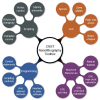The Nanolithography Toolbox
- PMID: 34434635
- PMCID: PMC7339749
- DOI: 10.6028/jres.121.024
The Nanolithography Toolbox
Abstract
This article introduces in archival form the Nanolithography Toolbox, a platform-independent software package for scripted lithography pattern layout generation. The Center for Nanoscale Science and Technology (CNST) at the National Institute of Standards and Technology (NIST) developed the Nanolithography Toolbox to help users of the CNST NanoFab design devices with complex curves and aggressive critical dimensions. Using parameterized shapes as building blocks, the Nanolithography Toolbox allows users to rapidly design and layout nanoscale devices of arbitrary complexity through scripting and programming. The Toolbox offers many parameterized shapes, including structure libraries for micro- and nanoelectromechanical systems (MEMS and NEMS) and nanophotonic devices. Furthermore, the Toolbox allows users to precisely define the number of vertices for each shape or create vectorized shapes using Bezier curves. Parameterized control allows users to design smooth curves with complex shapes. The Toolbox is applicable to a broad range of design tasks in the fabrication of microscale and nanoscale devices.
Keywords: CAD; lithography; nanofabrication; nanofluidic; nanophotonic; nanoplasmonic; nanoscale curved features; nanoscale design; nanoscale devices.
Figures








References
-
- Isaacson M, Murray A (1981) Insitu Vaporization of Very Low-Molecular Weight Resists Using 1–2 Nm Diameter Electron-Beams. J Vac Sci Technol 19(4):1117–1120. 10.1116/1.571180 - DOI
-
- Chou SY, Krauss PR (1997) Imprint lithography with sub-10 nm feature size and high throughput. Microelectronic Engineering 35(1):237–240. 10.1016/S0167-9317(96)00097-4 - DOI
-
- Guillorn MA, Carr DW, Tiberio RC, Greenbaum E, & Simpson ML (2000) Fabrication of dissimilar metal electrodes with nanometer interelectrode distance for molecular electronic device characterization. Journal of Vacuum Science & Technology B 18(3):1177–1181. 10.1116/1.591355 - DOI
-
- Yasin S, Hasko DG, Ahmed H (2001) Fabrication of <5 nm width lines in poly(methylmethacrylate) resist using a water:isopropyl alcohol developer and ultrasonically-assisted development. Appl Phys Lett 78(18):2760–2762. 10.1063/1.1369615 - DOI
-
- Word MJ, Adesida I, & Berger PR (2003) Nanometer-period gratings in hydrogen silsesquioxane fabricated by electron beam lithography. Journal of Vacuum Science & Technology B 21(6):L12–L15. 10.1116/1.1629711 - DOI
LinkOut - more resources
Full Text Sources
Other Literature Sources
Miscellaneous
